ADVERTISEMENT
Addressing Sesamoid Injuries In A Dancer
I recently got the following message from a patient:
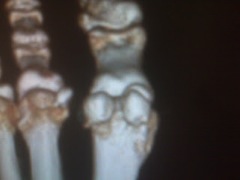 I am a 29-year-old female dancer. I noticed some pain in the ball of the left foot. I stopped dancing for one week and it got better so I resumed. However, the pain returned very gradually. A sports medicine orthopedic doctor diagnosed it as "sesamoiditis" and seemed confident of his diagnosis so I declined an X-ray. I avoided jumps in dance classes as I had done since the onset of the pain but I continued dancing. The pain very gradually became worse.
I am a 29-year-old female dancer. I noticed some pain in the ball of the left foot. I stopped dancing for one week and it got better so I resumed. However, the pain returned very gradually. A sports medicine orthopedic doctor diagnosed it as "sesamoiditis" and seemed confident of his diagnosis so I declined an X-ray. I avoided jumps in dance classes as I had done since the onset of the pain but I continued dancing. The pain very gradually became worse.
I stopped dancing and sought physical therapy. However, after three sessions (involving ultrasound, iontophoresis, soft tissue mobilization, taping and home exercises), my foot was swollen and it was painful to walk. A different orthopedic surgeon took X-rays and diagnosed my injury as a non-union fracture of the fibular sesamoid. (A pre-injury X-ray ruled out a bipartite sesamoid fracture.) I was in a walking boot for a month and was subsequently on crutches. The orthopedic surgeon said that if my bone was not healed after eight weeks of non-weightbearing, it would require surgical excision of the fibular sesamoid.
A podiatrist has been more conservative in his treatment. I began using a bone growth stimulator once a day for 30 minutes. After my four-week check-up, the podiatrist added a twice daily contrast bath to my regimen along with continued use of the bone growth stimulator. I am still non-weightbearing. I have also been taking calcium supplements, drinking milk and eating yogurt this whole time.
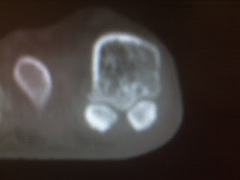 My concerns/questions are:
My concerns/questions are:
1. Is there anything else I should be doing to heal this bone (without surgery)? When I get back to dancing, how can I avoid future injury to the fibular and tibular sesamoids?
2. I would do anything to save the fibular sesamoid rather than have it surgically removed as I fear it will compromise my dancing. However, is there a point at which we can be fairly certain that the bone will not heal and I will have to resort to the surgery?
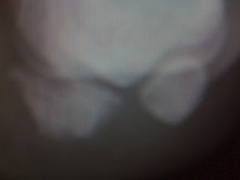 3. What risks would surgical removal of fibular sesamoid involve? Again, my main concern is with the function of my foot. I am very active and want to be able to dance for the rest of my life.
3. What risks would surgical removal of fibular sesamoid involve? Again, my main concern is with the function of my foot. I am very active and want to be able to dance for the rest of my life.
4. Is arthroscopic surgery an option?
5. I have struggled to trust my doctors. What do I look for in a surgeon (if it comes to that)? Should I go with a podiatrist or an orthopedic surgeon?
A Closer Look At The Sesamoid Bones
The two sesamoid bones protect the first metatarsal from direct pressure and they separate the tendons from the joint axis, increasing the lever arm of these tendons. An increased lever arm means increased power from these tendons, which at times need to handle the force generated up to five times body weight. The photo above at left shows these sesamoids sitting under the first metatarsal with a fibular fracture. In this example, you can clearly see how the fibular sesamoid looks irregular. The fracture to that fibular sesamoid occurred 10 months previous to the image being taken.
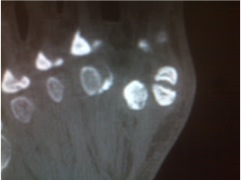 At times, the sesamoid bones never completely fuse in adolescence so X-rays show that they are bipartite or tripartite. The photo at the right shows a non-painful bipartite tibial sesamoid.
At times, the sesamoid bones never completely fuse in adolescence so X-rays show that they are bipartite or tripartite. The photo at the right shows a non-painful bipartite tibial sesamoid.
Physicians can misread fractures on X-rays as bipartite or tripartite sesamoids, and bipartite/tripartite sesamoids as fractures. Bone scans or magnetic resonance imaging (MRI) can help one make the diagnosis of a sesamoid fracture when it is not completely obvious as in the X-ray above.
As an aside, ultrasound is contraindicated for stress fractures. This is probably why physical therapy aggravated the situation in this case. Here is the Golden Rule of Foot: If ultrasound irritates the injured area, consider that an underlying fracture may be present.
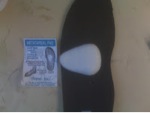 Answering The Patient’s Questions
Answering The Patient’s Questions
1. Is there anything else this patient can do to heal the bone in an attempt to avoid surgery? How can she avoid future injury to her fibular and sesamoid? This is a perfect time when the bone is sensitive to design perfect orthotic devices to protect the sesamoid. Most sports medicine podiatrists and physical therapists can design decent orthotics for this problem. The patient may have a biomechanically challenging foot with a very prominent first metatarsal and this could actually take the work of a biomechanical expert. The goal of any orthotic device is to shift weight back onto the arch and the second and third metatarsals. Without a corrective orthotic device, at some point in each step, 100 percent of the body weight goes through the big toe joint and sesamoids. In the front of the orthotic device, one should utilize a reverse Morton's extension, also called a dancer's pad, and sometimes an additional metatarsal pad.
Patients should not stop using the bone stimulator too early. If they are using the bone stimulator, they should be committed to it for nine months. When managing this patient’s care, the treating physician will need to balance her pain with a gradual increase in function. It can be a trade-off to allow more function with a little more pain initially.
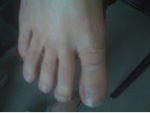 One can educate the patient on how to do spica taping to restrict big toe joint dorsiflexion with Kinesio Tape (Kinesio Holding Corporation). The photo at right shows the placement of 1-inch Kinesio Tape. Patients can apply the tape easily, restricting the upward motion of the toe without pulling the toe down. It should not feel like it is tight or jerky on the toe. Patients can experiment with longer arms of the tape under the arch. The 1-inch tape is split in two for 1 inch to wrap around the toe. An upcoming post will show a video on this technique.
One can educate the patient on how to do spica taping to restrict big toe joint dorsiflexion with Kinesio Tape (Kinesio Holding Corporation). The photo at right shows the placement of 1-inch Kinesio Tape. Patients can apply the tape easily, restricting the upward motion of the toe without pulling the toe down. It should not feel like it is tight or jerky on the toe. Patients can experiment with longer arms of the tape under the arch. The 1-inch tape is split in two for 1 inch to wrap around the toe. An upcoming post will show a video on this technique.
Staying strong with the foot intrinsic muscles, knees, hips and core will help the patient heal faster. The weaker patients become, the more the arch collapses into the ball of the foot and the more pressure there is on the sesamoids. This patient needs a smart physical therapist to begin re-strengthening the body.
The treating clinician should obtain a Vitamin D 25 level as well as a bone density screen to make sure everything is perfect in those two areas. This patient should be taking 1,500 mg of calcium. This normally involves five daily servings of calcium-rich food or supplementing her diet with 500 mg sugar-free Tums at the end of each day to make up the difference. Encourage the patient to eat a healthy, balanced diet.
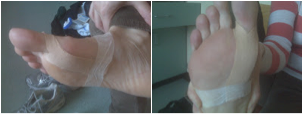 The patient should strive to ensure a relatively pain-free environment while transitioning from a non-weightbearing to a weightbearing removable cast. This should hold true as well with subsequent transitions to an athletic shoe and orthotic and tape; a smaller orthotic with dressier shoes and tape; and dance shoes with dancer’s pads and Hapad arches and tape. Then there should be a gradual return through the various levels of difficulties in dance.
The patient should strive to ensure a relatively pain-free environment while transitioning from a non-weightbearing to a weightbearing removable cast. This should hold true as well with subsequent transitions to an athletic shoe and orthotic and tape; a smaller orthotic with dressier shoes and tape; and dance shoes with dancer’s pads and Hapad arches and tape. Then there should be a gradual return through the various levels of difficulties in dance.
2. When does the fibular sesamoid need surgery? The sesamoid on a computed tomography (CT) scan will show irregularity at the interface with the bottom of the metatarsal head, which will break down the metatarsal head cartilage over time and cause a worse problem. This was the case of the patient with the X-ray above when I first met her.
Surgery is also indicated if the MRI shows damage to the underlying first metatarsal. However, the use of a bone stimulator may show healing on serial MRIs over a one- or two-year period of time. I definitely feel surgery for this injury is an individual decision. This patient is a candidate for surgery three months after injury.
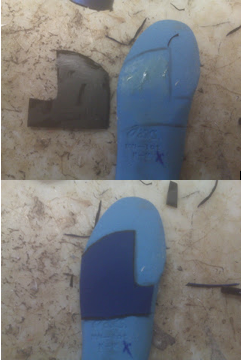 3. What are the risks, especially in an active person, of removing the fibular sesamoid? When one removes the sesamoid, the patient can be extremely active at a professional level but must always try to protect the other sesamoid with orthotic devices, dancer's pads, etc. Most doctors underplay the actual time it can take a high level athlete to get back to performing or back to the field of play. I believe there is a two-year total healing time to a strong and powerful big toe joint following surgery. The first year is all about swelling, initial strength, scar tissue and biomechanics. The second year is re-strengthening not necessarily tone but power, endurance and quickness. Caution the patient that surgery can have a normal array of problems, such as excessive swelling, incomplete correction requiring re-operation, excessive scarring causing stiffness/pain, tendon balance problems requiring prolonged taping and many other issues. Hallux varus is rare.
3. What are the risks, especially in an active person, of removing the fibular sesamoid? When one removes the sesamoid, the patient can be extremely active at a professional level but must always try to protect the other sesamoid with orthotic devices, dancer's pads, etc. Most doctors underplay the actual time it can take a high level athlete to get back to performing or back to the field of play. I believe there is a two-year total healing time to a strong and powerful big toe joint following surgery. The first year is all about swelling, initial strength, scar tissue and biomechanics. The second year is re-strengthening not necessarily tone but power, endurance and quickness. Caution the patient that surgery can have a normal array of problems, such as excessive swelling, incomplete correction requiring re-operation, excessive scarring causing stiffness/pain, tendon balance problems requiring prolonged taping and many other issues. Hallux varus is rare.
4. Is arthroscopic surgery an option? No, the joint is too small. Most surgeons approach the fibular sesamoid from the bottom of the foot for easy access.
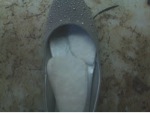 5. What should the patient look for in a surgeon, and should it be a podiatrist or orthopedist? It is ideal for the patient to find a podiatrist or orthopedist who does surgery, and one who also pays a lot of attention to rehabilitation and biomechanics. Most surgeons create a team to deal with this problem. The top surgeon at my facility will refer to me for the orthotic devices and some of the rehab, and physical therapists and trainers for the rest of the rehab.
5. What should the patient look for in a surgeon, and should it be a podiatrist or orthopedist? It is ideal for the patient to find a podiatrist or orthopedist who does surgery, and one who also pays a lot of attention to rehabilitation and biomechanics. Most surgeons create a team to deal with this problem. The top surgeon at my facility will refer to me for the orthotic devices and some of the rehab, and physical therapists and trainers for the rest of the rehab.
I am biased toward my profession but surgeons in general only have time to focus on surgery. The patient should find a surgeon who embraces the team approach for the rehabilitation phase after the surgeons have pronounced the patient "cured."











